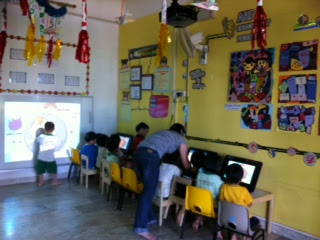Problems leading to concept
22 different problems were shown to given to us to solve during the 6 days. The biggest problem of all was the quiz, which we had to go out to different area around our school to answer the question given. It was a true test to our brain on other methods we can use to derive the answer without any tool used. Rachel and I used my shoe as a guide to measuring various items. We also used other tools like pen and pencil as our measuring tools. Most importantly, Dr. Yeap taught and challenge us to think out of the box, finding other ways to solve the given problems.
Some of my favourite problems which can be used with our preschoolers:
- Poker card trick
- Using literature book in teaching mathematics - Spaghetti & Meatballs for all
- Salute
- Think of two digits
- Using toothpicks to form shapes
Learning the CPA learning theory by Jerome Bruner:
1st Phase: Using real life objects to teach Mathematical concepts.
2nd Phase: Learning Mathematical concepts through the use of objects like counters and unifix cubes.
3rd Phase: Using pictures and photographs
4th Phase: Using drawings which are abstract
This allows us to build our current knowledge on what we know about learning Mathematics. This can also be shown clearly in Dr. Yeap's lesson as he demonstrated the concept according to Bruner. Dr. Yeap also constantly relates the activities to Bruner's theory and how children learnt. Learning Mathematical concept through manipulatives materials do involve children in their learning process thus children can remember longer.
Language and terms used in Mathematics
Language plays an important role when teaching Mathematics concepts to young children. Use of wrong word or phrases may affect the child's understanding as he/she progress to higher level of Mathematics. Some of the common mistakes made by teachers were shared as follows:
Wrong: Take away
Right: Subtract or Minus
Wrong: Fraction - 3 out of 4
Right: 3 fourths of 4 or 3 quarters
Wrong: Digit V.S. Number
Right: Digit is for 1 - 9 and Number is 1 - 10
Wrong: "The shoe is the length of 5 paper clips" Measuring using objects.
Right: "The shoe is about the length of 5 paper clips" (Reason: Because it is an estimation and the number varies if the length of paper clips are different."
Wrong: Pen and Pencils cannot be added, even though the child refers them as items.
Right: Things with different nouns cannot be added. This will the child to develop understanding when ones learn algebra. This is because you cannot add X & Y.
Wrong: Cookies and stones cannot be divided as it is discreet quantity.
Right: Only continous quantity can be divided - sugar, rice...)
Big Ideas on Numbers:
- Knowing numbers is a "Big Idea" in Mathematics. Children learn mathematics by asking questions and teacher's facilitation. (Cardinal, Ordinal, Nominal and Measurement Numbers)
- Children needs to know what can be and cannot be added in counting.
- When learning to add big numbers, teach children to group and upgroup numbers into tens. This will help children to understand number bonds.
- Number is an important concept in whole number. Children need to know how to break number up appropriately.
- Leaning conceptual meaning of four basic opertations (+, -, x, ÷)
Questions:
1. What other ways can we best support children with special needs in learning mathematical concepts?
2. I head about lesson studies as shared by Lynn Heng during her talk that Dr. Yeap knows about this. Will it possible to share with us about lesson studies during our next module?






